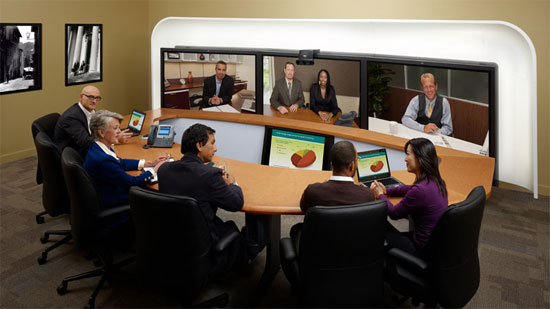Or at least it’s growing highly averse to it. And considering the state of teleconferencing tech today and its potential to cut carbon emissions, good for them.
SAP, which is making a serious push to reduce its environmental impact and help other organizations measure and reduce theirs, relies primarily on teleconferencing technologies to conduct its sustainability council meetings. Kristina Grifantini’s article in Technology Review reveals that it’s not a token gesture by SAP to appear green, but a serious investment by the company. She writes:
SAP has more than 500 videoconferencing systems and 29 of the newer telepresence rooms, which are supplied by Cisco Systems. And it plans to add 15 of the Cisco rooms by the end of the year. It costs $300,000 to install each of the most advanced rooms, but the average intercontinental business trip runs “$10,000, at least,” Graf says. “The system pays for itself in a year.”
How’s that for a testimonial? An added bonus: an improved work-life balance, since a drive to the local office for a meeting with faraway colleagues is far less disruptive than a multi-day trip away from home.
According to the piece, “Cisco has sold more than 400,000 systems to 2,000 customers.” That figure is sure to grow as large companies like Microsoft, which spends hundreds of millions of dollars on travel yearly, turn to telepresence. And it’s not just viewed as a cost reduction strategy, but also as the basis of new business models that encompass both internal processes and relationships with outside customers and partners.
But what if you’re not a huge, multinational corporation? Recent history suggests that Cisco is working hard — or at least paying big — to capture SMB budgets and end up with a sizable chunk of a global telepresence technology market that’s expected to grow to $4.7 billion by 2014 as forecast by Frost & Sullivan. Cisco acquired Tandberg, a company that specializes in cheaper, more compact teleconferencing systems for $3.3 billion in a deal that was completed in April of last year. The company is even giving the average home a shot with Umi, a device that links friends and family through their living rooms and broadband connections.
And Cisco’s not alone in pursuing the telepresence opportunity. Microsoft Research is lending some of its muscle toward advanced, immersive remote meetings. And the company’s white hot Kinect 3D motion sensing accessory for the Xbox 360 has captured the hacker community’s imagination, resulting in impressive tech demos and setting enthusiasts on the path toward telepresence scenarios that were once the stuff of wishful, sci-fi thinking.
Image credit: Cisco


[…] This post was mentioned on Twitter by ecoINSITE, Pedro Hernandez. Pedro Hernandez said: RT @ecoINSITE: #Telepresence today: SAP’s sustainability council is allergic to air travel http://bit.ly/fCvSJO #greenIT […]